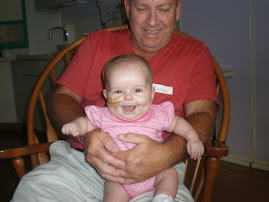(Abigail's heart condition)
Well we received the news yesterday that they would rather do her next surgery (the Glenn Shunt) sooner than later. So the BIG day is planned for Sept 17th. As they have told us many times before, nothing is set in stone.... if for some reason it becomes more urgent they will do it sooner. Or if something more urgent comes up for someone else she could get bumped. They have also talked about enlarging some valve (not sure which one, cause they really haven't said) with the next surgery also. They think too much blood is accumulating in the right atrium and it is kind of backing up, too much blood flow to the liver and bowel. They think that this affecting her appetite which= her poor eating habits and difficulty gaining weight. They placed a NG (nasogastric/ feeding tube) down her nose last night. Anything she doesnt eat by the bottle will go down that. Hoping to "bulk" her up before surgery. I guess that means for 3 wks... and she has already pulled it out once. But doing well in hospital. Gained weight today, yeah!
Just a copy and paste of the Glenn Shunt Proceure (which is done open heart) and description of HRHS....ope this helps explain stuff.
Glenn shunt: A surgical operation for children born with cyanotic heart disease ("blue babies"), in which a large vein (the superior vena cava) is anastomosed (connected) to the right pulmonary artery so that blood bypasses the malformed right chambers of the heart and is shunted directly into the lungs to be oxygenated.
What is hypoplastic right heart syndrome (HRHS)?
Hypoplastic Right Heart Syndrome (HRHS) is a condition that is even more rare than Hypoplastic Left Heart Syndrome (HLHS). HRHS refers to the underdevelopment of the right side structures of the heart, which means that the chambers, valves and related blood vessels on the right side of the heart are malformed. This malformation involves the pulmonary valve atresia which has not formed, a very small right ventricle, a small tricuspid valve and a small hypoplastic pulmonary artery. As the ventricle has failed to grow and develop the ventricles muscle structure is poor, so additional problems are encountered as the heart attempts to pump blood to the pulmonary valve for transfer to the lungs. The proper amount of blood pumped from the right atrium is not sufficient and this causes the blood to be not pumped efficiently to the lungs.
Main Problem:
Pulmonary valve atresia which is absent is a valve that normally opens and closes to let blood flow to the pulmonary artery.
Pulmonary valve atresia which is absent is a valve that normally opens and closes to let blood flow to the pulmonary artery.
Secondary Problems
A very small (hypoplastic) right ventricle is the lower chamber which normally pumps blood to the lungs,
A small tricuspid valve which is the valve that allows blood to flow into the right ventricle
A small (hypoplastic) pulmonary artery.
The blood flow into the coronary arteries may be abnormal causing damage to the heart muscle
A very small (hypoplastic) right ventricle is the lower chamber which normally pumps blood to the lungs,
A small tricuspid valve which is the valve that allows blood to flow into the right ventricle
A small (hypoplastic) pulmonary artery.
The blood flow into the coronary arteries may be abnormal causing damage to the heart muscle

























No comments:
Post a Comment